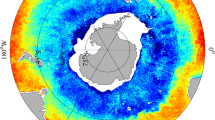Abstract
The data from the Scanning Multichannel Microwave Radiometer (SMMR) sensor on board the NIMBUS 7 satellite in the 18 and 21 Ghz channels are used to derive the Precipitable Water (PW) over the tropical Indian Ocean for the period May–September, 1979. The PW values are derived by using both the horizontal and vertical polarization channels. These PW values along with the satellite-derived sea surface temeprature (SST) and the lower tropospheric wind (UW) data reveal the features of the summer monsoon circulation of the tropical Indian Ocean in 1979. Further, the derived PW values from Nimbus 7 SMMR data agree well with features of PW presented by Cadet (1983) inferred from the TIROS—N soundings and FGGE data.
Similar content being viewed by others
References
Cadet, D. L.: 1983, ‘Mean Fields of Precipitable Water over the Indian Ocean during the 1979 Summer Monsoon from TIROS-N Soundings and FGGE Data’,Tellus 35, 329–345.
Cadet, D. L., Sommeria, G., and Ryes, S.: 1981, Early Results from Balsamine Experiment: International Conference on Early Results of FGGE and Large Scale Aspects of its Monsoon Experiment. ICSU, WMO, Geneva, Tallahassee, Florida, U.S.A.
Cadet, D. L., and Greco, S.: 1987, ‘Water Vapour Transport over the Indian Ocean during the 1979 Summer Monsoon. Part I Water Vapour Fluxes’,Mon. Wea. Rev. 103, 148–158.
Liu, W. T.: 1986, ‘Statistical Relation between Monthly Mean Precipitable Water and Surface Level Humidity over Global Oceans’,Mon. Wea. Rev. 114, 1591–1602.
Narayanan, M. S., and Rao, B. M.: 1989, ‘Stratification and Convection over the Arabian Sea During Monsoon 1979 from Satellite Data’,Proc. Ind. Acad. Sci. (Earth Planet. Sci.) 98, 339–352.
Prabhakara, C., Chang, H. D., and Chang, A. T. C.: 1982, ‘Remote Sensing of Precipitable Water over the Oceans from Nimbus 7 Microwave Measurements’,J. Appl. Meteorol. 21, 59–68.
Ramesh Kumar, M. R., Sathyendranath, S., Viswambharan, N. K., and Gangadhara Rao, L. V.: 1986, ‘Sea Surface Temperature Variability over the North Indian Ocean—A Study of Two Contrasting Monsoon Seasons’,Proc. Ind. Acad. Sci. (Earth Planet. Sci.) 95, 435–446.
Sadhuram, Y. and Ramesh Kumar, M. R.: 1988, ‘Does Evaporation Arabian Sea Play a Major Role in Moisture Transport Across the West Coast of India during Active Monsoon Period?’,Mon. Wea. Rev. 116, 307–312.
Vinayachandran, P. N. and Ramesh Kumar, M. R.: 1990, ‘Water Vapour Flux Divergence over the Arabian Sea during 1987 Summer Monsoon using Satellite Data’,Boundary-Layer Meteorol. 51, 199–209.
Young, J. A., Hassan, V., Donald P. Wylie, and Cecil, Lo.: 1980, ‘Summer Monsoon Windsets from Geostationary Satellite Data, Summer MONEX: 1 May–31 July, 1979’, Madison, University of Wisconsin, U.S.A., 127 pp.
Author information
Authors and Affiliations
Rights and permissions
About this article
Cite this article
Ramesh Kumar, M.R., Muralidharan, P.M. & Sathe, P.V. Precipitable water over the tropical Indian Ocean derived from NIMBUS 7 satellite data — A case study. Boundary-Layer Meteorol 66, 325–330 (1993). https://doi.org/10.1007/BF00705481
Received:
Issue Date:
DOI: https://doi.org/10.1007/BF00705481



